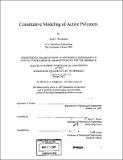| dc.contributor.advisor | Mary C. Boyce. | en_US |
| dc.contributor.author | Therkelsen, Scott V. (Scott Vincent), 1980- | en_US |
| dc.contributor.other | Massachusetts Institute of Technology. Dept. of Mechanical Engineering. | en_US |
| dc.date.accessioned | 2006-03-24T18:40:08Z | |
| dc.date.available | 2006-03-24T18:40:08Z | |
| dc.date.copyright | 2005 | en_US |
| dc.date.issued | 2005 | en_US |
| dc.identifier.uri | http://hdl.handle.net/1721.1/30323 | |
| dc.description | Thesis (S.M.)--Massachusetts Institute of Technology, Dept. of Mechanical Engineering, 2005. | en_US |
| dc.description | Includes bibliographical references. | en_US |
| dc.description.abstract | This thesis develops a three-dimensional constitutive model of active polymeric materials, including changes in material volume and properties due to actuation. Active polymers reversibly change shape, volume and/or material properties in response to some external stimulus. Electric fields are a common driving force for this actuation, though changes in pH, temperature, magnetic field, or visible light have been studied in their role as stimuli. The study and future use of conducting polymer actuators is important because of their potential to meet and exceed the capabilities of currently available materials in a variety of fields, most notably in the field of artificial muscles. This thesis first reviews the basic principles of continuum mechanics, followed by a review of the classical and current statistical mechanics based constitutive models for rubber-like materials. A theoretical model for reversibly swelling active polymer gels is presented. Material responses to different homogeneous deformation conditions are then studied as a function of swelling. The effect of inert rigid filler particles on the swelling behavior of an active polymer is then studied using a closed-form solution of a boundary value problem developed in the literature. The constitutive model is also used in a study of the behavior of a bimorph strip, noting that the responsive nature of active polymers is often mechanically accentuated by layering with other materials, with implications for future work on transient analysis. Finite element analysis is implemented for verification and analysis of the boundary value problem. | en_US |
| dc.description.statementofresponsibility | by Scott V. Therkelsen. | en_US |
| dc.format.extent | 96 leaves | en_US |
| dc.format.extent | 5550041 bytes | |
| dc.format.extent | 5561001 bytes | |
| dc.format.mimetype | application/pdf | |
| dc.format.mimetype | application/pdf | |
| dc.language.iso | eng | en_US |
| dc.publisher | Massachusetts Institute of Technology | en_US |
| dc.rights | M.I.T. theses are protected by copyright. They may be viewed from this source for any purpose, but reproduction or distribution in any format is prohibited without written permission. See provided URL for inquiries about permission. | en_US |
| dc.rights.uri | http://dspace.mit.edu/handle/1721.1/7582 | |
| dc.subject | Mechanical Engineering. | en_US |
| dc.title | Constitutive modeling of active polymers | en_US |
| dc.type | Thesis | en_US |
| dc.description.degree | S.M. | en_US |
| dc.contributor.department | Massachusetts Institute of Technology. Department of Mechanical Engineering | |
| dc.identifier.oclc | 61103720 | en_US |
